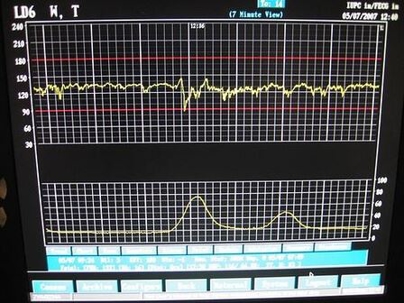Schedule a Consultation
216-621-3000Schedule a Consultation
216-621-3000
Perhaps the most important advance in obstetric medicine, electronic fetal monitoring (EFM) is a way for doctors and nurses to closely watch the condition of the unborn baby by observing the strength of the mother’s contractions and the baby’s heart rate. It is used at various times throughout the pregnancy, especially during visits where the doctor is concerned about the baby (for example, after a car accident), and during labor. This is often the first warning sign that doctors will have that the baby is in trouble.
There are two types of electronic fetal monitoring:
Electronic fetal monitoring has been accepted worldwide, which demonstrates physician confidence in the technology. Continuous monitoring is the standard of care for high risk pregnancies, and is even used routinely in low risk patients.
Some women desire a more “natural” birthing process, and seek to avoid the use of electronic fetal monitoring. Of course, women have the right to decide the scope of medical treatment. However, the physicians or other health care providers (for example, midwives must provide their patients with the necessary tools to make an informed decision. Patients must be informed about the risks and benefits of proceeding without electronic fetal monitoring, and they must consent to those risks. Failure to obtain informed consent is negligence.
Alternatives to electronic fetal monitoring include auscultation and Doppler. Auscultation is the use of a stethoscope to listen to the baby’s heartbeat—it is not as accurate as electronic fetal monitoring, and it provides no information about the mother’s contractions. A Doppler is a device that uses ultrasound to detect the baby’s heartbeat, and to project the sound through a speaker.
The most important part of electronic fetal monitoring is to pay attention to the results. Doctors and nurses won’t typically watch the “strips” continuously, but they should review the strips every time they come into the room, and modern machines can have alarms set to go off in concerning situations.
The strips generally look like two lengthwise rectangles. On each rectangle is a line, which denotes the baby’s heartbeat (upper rectangle) and the mother’s contractions (lower rectangle). The baby’s heart rate should normally range between 120 and 160 beats per minute. The heart rate will change when the baby moves, and during/immediately after a mother’s contraction.
The terminology used to interpret the strips changes from time to time. Important terms for patients and their families to listen for are: fetal stress, fetal distress, nonreassuring, ominous, tachycardia, bradycardia, variable decelerations, late decelerations, and sinusoidal. Each of these terms indicates that there may be some cause for concern.
When confronted with concerning findings, doctors will usually try to first rouse the baby. The mother may be moved on her left side, which allows for more blood to flow to the baby. She may be given an oxygen mask, or provided with orange juice or a fluid bolus (IV). The doctor may also stimulate the scalp of the baby during a vaginal examination. Sometimes, the baby’s heart rate will improve after these procedures.
EFM can help to alert medical providers to early fetal distress. If routine procedures do not improve the baby’s condition, it may be necessary to perform an emergency cesarean section to deliver the baby, who may not be receiving enough blood or oxygen. If the obstetrician does not act quickly, the baby may suffer permanent brain injury, developmental delays, cerebral palsy, or may die.
Our birth injury lawyers will be able to obtain the medical records from your hospital stay, and we will be able to examine firsthand the electronic fetal monitor strips. Those strips are often the best evidence of the baby’s condition during labor, and whether the obstetrician should have acted differently. For a no-cost medical review, contact our medical malpractice lawyers at 216-621-3000 or through our website’s contact form.

